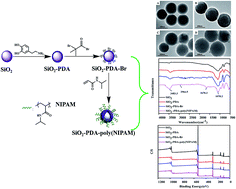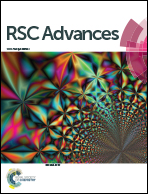Fabrication of silica nanoparticle based polymer nanocomposites via a combination of mussel inspired chemistry and SET-LRP†
Abstract
A highly benign, simple and effective strategy was successfully developed for the first time for the fabrication of hydrophilic thermo-responsive polymer modified silica nanoparticles (SiO2-PDA-poly(NIPAM)) at low temperature and under mild reaction conditions via a combination of mussel inspired chemistry and SET-LRP. The SiO2 NPs were first modified with polydopamine (PDA), which was formed by the self-polymerization of dopamine under rather mild conditions. 2-Bromo-2-methylpropionyl bromide was covalently attached on the surface of the PDA modified SiO2 NPs. Afterward, the poly(NIPAM) was grown in situ on the surface of the Br-containing SiO2 NPs by the SET-LRP method. Consequently, the surface of the SiO2-PDA nanoparticles is intrinsically covered by a layer of free poly(NIPAM) chains, which enables the poly(NIPAM) to be colloidally stable not only at room temperature, but also upon incubation in the presence of proteins under physiological conditions. After modifying with PNIPAM, the functional SiO2 NPs retain their pristine structure, however their dispersibility was significantly improved in polar and nonpolar solutions. As compared with previous methods, the strategy developed in this work is rather simple and effective. More importantly, due to the universality of mussel inspired chemistry, this novel strategy could also be used for the surface modification of many other materials.


 Please wait while we load your content...
Please wait while we load your content...